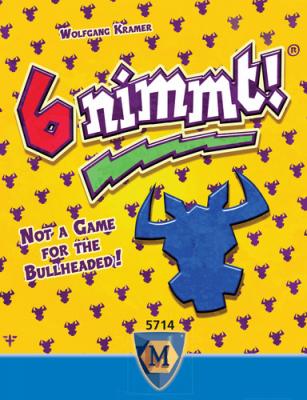I’ve just posted my latest YouTube video, in which I explain how to use binary numbers to jazz up your nail varnish:
Alongside this video, I also have an associated puzzle for you to think about.
I’ve just posted my latest YouTube video, in which I explain how to use binary numbers to jazz up your nail varnish:
Alongside this video, I also have an associated puzzle for you to think about.

In this series of posts, Katie will be going on about some of her favourite board games and card games, and some of the interesting mathematics to be found there. If you’d like the chance to play a mathematical board game, why not find or start a Maths Arcade at university, or join your local MathsJam.
6 Nimmt! (German: Take 6!) is a card-based game which involves a hand of numbered cards, each also containing a number of cow heads. The cards are played in rounds, and during each round everyone chooses a card to play, they’re played in order, and you may find yourself having to take cards. The aim of the game is to end with the fewest cow heads.

Countdown number-nerd Lovely Rachel Riley has appeared in the latest advert for mobile phone agglomerate EE, alongside massive film node Kevin Bacon.
In the advert, Riley is unable to work out how anyone could not be enticed by the high mobile internet speeds (50% faster, apparently) offered by the company who are paying her to not be able to do so, and this is illustrated by a whole board full of equations and numbers which don’t seem to come to anything. Or do they?
In this series of articles, I’m writing about mathematical questions we don’t know the answer to – which haven’t yet been proven or disproven. This edition is a topical one, for Pancake Day (Shrove Tuesday, celebrated in the UK this year on 9th February).
 Some of the best mathematical teasers are those which originate in a real-world problem – although the problem for pure mathematicians is that that happens much less often than it does for applied mathematicians, who are presented with interesting real-world problems all the time. That’s why it’s especially nice when a more pure one pops up, and that’s exactly what happened to mathematician Jacob E Goodman, back in 1975.
Some of the best mathematical teasers are those which originate in a real-world problem – although the problem for pure mathematicians is that that happens much less often than it does for applied mathematicians, who are presented with interesting real-world problems all the time. That’s why it’s especially nice when a more pure one pops up, and that’s exactly what happened to mathematician Jacob E Goodman, back in 1975.
Before Christmas, we launched a winter-themed maths competition – to design a sensible hexagonal snowflake, using a square grid, which could be used to knit a wintery jumper and not a) look terrible or b) have non-hexagonal symmetry. We had a deluge of entries, some valid and others less so – in fact, we may have had at least one entry break each of the rules we set. Below is a round-up of all the entries we received.

COMPETITION DEADLINE EXTENDED – SEE BELOW!
To celebrate the year end, as well as our daily Advent Calendar posts, we’re also running a little competition – last year we did a pun competition, and this year it’s something a bit more crafty – well, it’s a knitting competition in which the knitting is optional.
Christmas wrapping paper is sold in thousands of different variations, including plain, coloured, patterned, foiled and even flock, but one thing it’ll have in common is that it will repeat whatever pattern it has, regularly across the design.
I’m interested in symmetry, and was intrigued to find a curious fact about the symmetries of such repeating patterns – their symmetries are quite limited.